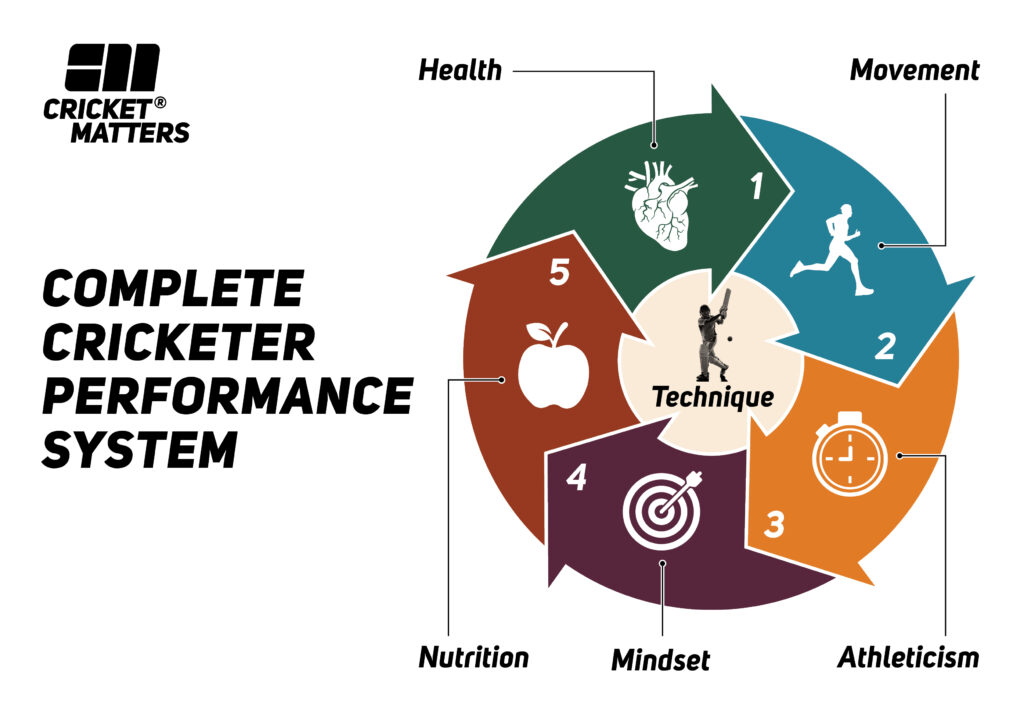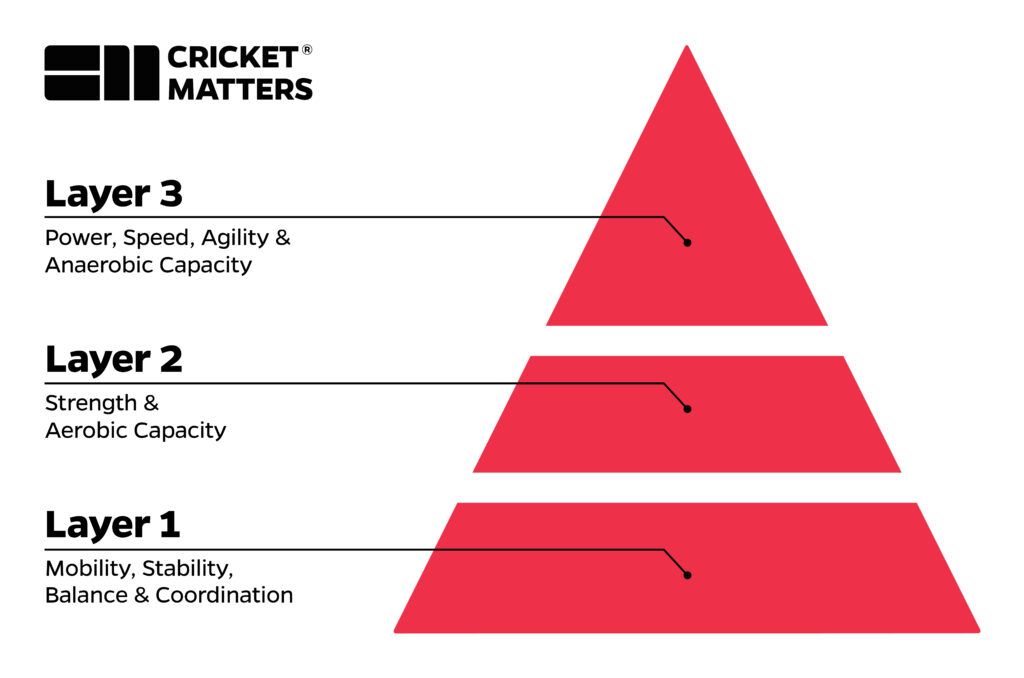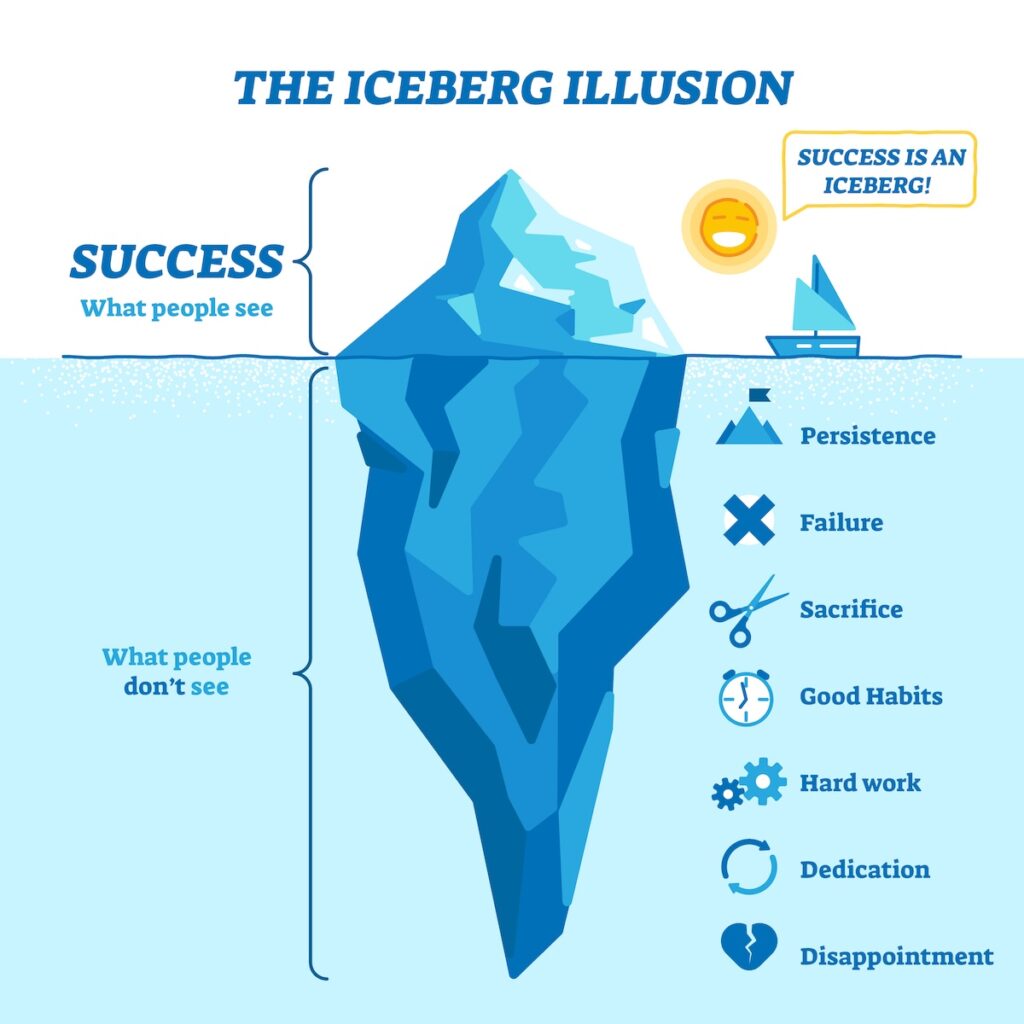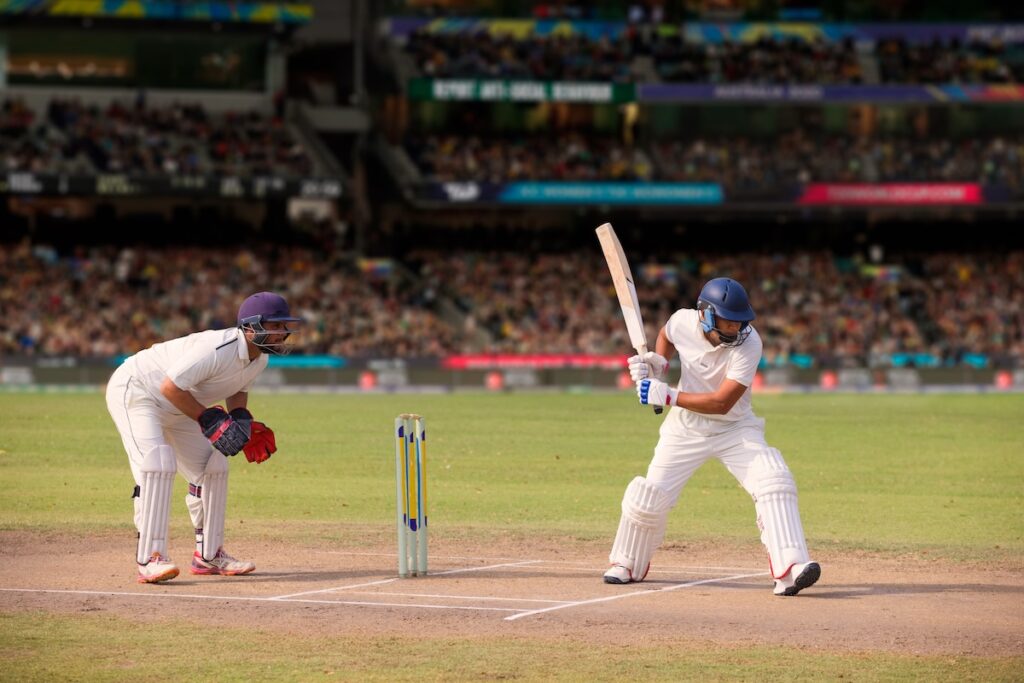
I hope you enjoy reading this blog post.
James Breese, Cricket Matters FounderIf you need my help with cricket coaching, strength and conditioning, injury rehab, or nutrition, click here.
Most cricketers hit a wall.
They spend hours in the nets, fine-tuning their technique. They shadow bat in front of mirrors, analysing every movement. They bowl for hours, chasing the perfect ball.
But when match day comes, something doesn’t click.
- The timing isn’t there.
- The feet don’t move as they should.
- The concentration waivers
And then, the frustration builds.
Cricket isn’t just about skill—it’s about execution under pressure, over long periods, in unpredictable conditions. The best players don’t just practice harder. They train smarter.
They know that batting technique crumbles if mobility is limited, bowling speed drops without strength and power, and decision-making slows when fatigue sets in. Poor hydration leads to sluggish footwork, missed chances, and mental lapses.
This is where The Cricketer Performance System comes in—a complete approach designed to develop the complete cricketer.
It’s not about quick fixes. It’s about building a foundation that makes skills work when it matters most.
Key Takeaways
- Technique is the Result, not the Starting Point—Technical adjustments will not translate into better match performance without addressing movement, strength, mindset, and recovery.
- Physical and Mental Readiness Dictate Consistency—Players who train their bodies, fuel properly, and sharpen their mindsets execute under pressure while others break down.
- The Best Players Train Beyond the Nets – Breaking through plateaus requires a complete approach—developing strength, mobility, resilience, and endurance, not just refining skills.
Table of Contents
The Five Pillars of the Cricketer Performance System
The best players in the world don’t just rely on skill; they build a foundation that allows them to execute under pressure, game after game.
That’s where The Cricketer Performance System comes in.
This system is built on five key pillars every cricketer needs to develop for long-term success.

Health: The Foundation That Supports Fitness and Performance
A cricketer’s health matters above all else.
Without good health, fitness, and training, performance falls apart.
No amount of skill or conditioning can compensate for poor physical or mental well-being.
At Cricket Matters, we prioritise health before fitness, ensuring players have the foundation to train, recover, and perform at their best.
While fitness is about strength, endurance, and agility, health is about sustainability, longevity, and resilience.
We assess health in two critical areas: physical and mental. A strong body and a focused mind set the stage for sustained improvement.
If players are constantly fatigued, struggling with recovery, or mentally burned out, their fitness and cricketing performance will always be inconsistent.
Before pushing physical limits, we encourage all cricketers to get a medical check-up—understanding their health status is the first step towards structured improvement. Once cleared, we assess:
- Body – Overall physical readiness, weight management, and energy balance.
- Lifestyle – Sleep, hydration, stress levels, and habits that impact well-being.
- Mortality – Identifying potential long-term health risks that could affect career longevity.
- Breathing – Oxygen efficiency and lung capacity, both of which affect stamina and mental clarity.
Health isn’t about short-term gains—it’s about setting up a cricketer’s body and mind for long-term success.
When health is prioritised, players train harder, recover faster, and consistently perform across seasons.
Movement: The Key to Efficiency and Control

At Cricket Matters, we take a top-to-toe approach to movement, ensuring every cricketer moves efficiently, powerfully, and without pain.
Cricket is a game of dynamic movements—whether it’s stepping into a drive, pivoting for a throw, or generating speed through the bowling action. But performance will always be limited without proper mobility, stability, and control.
That’s why we assess movement at two levels:
- Level 1: Baseline Human Movement – The foundation that every cricketer (and human) should meet. If you can’t move well in everyday life—without restrictions, compensations, or pain—there’s no point progressing to sport-specific work.
- Level 2: Cricket-Specific Movement – Once a player meets the baseline, we assess whether their movement patterns support the demands of the game. This includes rotational power for batting, single-leg stability for fast bowling, and agility for fielding.
However, we screen for pain before anything else.
If pain is present, there’s no point in working on mobility, strength, or skill—it has to be addressed first.
Our in-depth clinical approach ensures that players aren’t just moving better but moving pain-free.

Have You Downloaded Our FREE 7-Day Gym Workout Plan?
Grab your complete step-by-step 7-day gym workout plan for cricketers today. There will be no more Guesswork. Just follow the plan and get results.
How Movement Affects Cricket Performance
Movement efficiency isn’t just about injury prevention—it directly impacts performance outcomes.
For example, research on pace bowlers in cricket suggests that improving hip and pelvis mobility can help maintain better bowling kinematics, reduce injury risk, and potentially increase bowling speed (Forrest et al., 2020).
Without adequate hip mobility, a bowler compensates elsewhere, leading to excessive strain on the lower back and an inefficient bowling action. This reinforces why movement screening is essential before making technical changes.
Players unlock better efficiency, quicker reactions, and reduced injury risk by systematically improving their movement, starting with the fundamentals and progressing to cricket-specific demands.
Every aspect of their game improves with a body that moves as it should.
Athleticism: Strength, Power, and Speed in Cricket

Athleticism is the engine that drives cricket performance. Strength, power, and speed dictate how fast you bowl, how hard you hit, and how quickly you react in the field.
Without them, even the best technique falls apart under fatigue.
At Cricket Matters, we structure athletic development through the Cricket Performance Pyramid, ensuring players build physical resilience and performance capacity step by step.

Layer 1: The Foundation – Mobility, Stability, Balance, and Coordination
Before chasing speed or power, every cricketer needs a stable, mobile base.
If you lack mobility or balance, you’ll struggle to execute movements efficiently—whether standing strong in your stance, transferring weight through a shot, or landing safely after a delivery stride.
Layer 2: Strength and Aerobic Capacity
Strength isn’t just about lifting heavy—it’s about developing the force needed to control movement and generate power.
A stronger cricketer is a more stable, efficient, and explosive cricketer.
Aerobic capacity is equally critical; without endurance, footwork slows, decision-making drops, and consistency suffers over long matches.
Layer 3: Power, Speed, Agility, and Anaerobic Capacity
Once a solid base is in place, we build the top layer—the qualities that separate good players from great ones. Power is essential for fast bowling and explosive batting.
Speed and agility dictate reaction times, sprint efficiency, and fielding sharpness. Anaerobic capacity ensures you can repeat high-intensity efforts without fading.
Cricketers who skip foundational layers often hit performance roadblocks or suffer repeated injuries. But those who build strength, power, and speed in the right order stay sharp, recover faster, and perform at their peak when it matters most.
Mindset: The Mental Game Defines Success

Cricket isn’t just a test of skill and fitness—it’s a battle of the mind.
The best players don’t just rely on talent; they master the mental side of the game to make smart decisions under pressure, stay composed in tough moments, and execute their skills consistently.
Yet, many cricketers overlook mindset training. They focus on technique and fitness but neglect the hidden factor that often makes the biggest difference—mental resilience.
Decision-Making Under Pressure
Every ball in cricket presents a decision—what shot to play, how to adjust to the bowler, when to attack or defend. Poor decision-making often isn’t a skill issue; it’s a mental one.
Research has shown that mental fatigue significantly reduces reaction time, making athletes slower to respond under pressure (Sun et al., 2024).
A meta-analysis found that reaction time decreased by 0.871 effect size (p < 0.001) when athletes were mentally fatigued. In cricket, this means delayed shot selection, late foot movement, and hesitation in the field—errors that can cost matches.
Without mental conditioning, even the most physically prepared cricketers will struggle to execute under pressure.
Training the mind to stay clear, process information quickly, and remain composed in high-pressure moments is what separates great players from the rest.
Confidence and Composure
Confidence isn’t something you just “have”—it’s built through preparation, routines, and mental conditioning.
Doubt creeps in when players aren’t physically prepared or lack strategies to manage nerves.
The most composed players rely on a structured mental approach, from pre-ball routines to breathing techniques that keep them locked in.
Handling Pressure and Fatigue
Mental fatigue is just as damaging as physical fatigue.
Tired minds lead to slow reactions, poor shot selection, and lapses in concentration.
This is why elite players train their focus just like they train their bodies—using techniques to stay present, reset after mistakes, and maintain clarity deep into a game.
Overcoming Setbacks: The Key to Long-Term Success
Failure is part of cricket. Every batsman gets out, every bowler gets hit for runs, and every fielder drops a catch at some point.
But what separates top players is how they respond to setbacks.
Instead of dwelling on mistakes, great cricketers learn, adapt, and move forward quickly.
They don’t let one bad innings define them. They reflect on what went wrong, adjust their approach, and return stronger.
A strong mindset means bouncing back faster, staying focused on long-term progress, and not letting short-term failures shake confidence. Mental resilience isn’t about avoiding failure—it’s about using it as fuel to improve.
A cricketer’s mental game is their most potent asset.
Train the mind like you train the body, and you’ll become more consistent, adaptable, and resilient—ready for whatever the game throws at you.
Nutrition: Fueling for Performance and Recovery

Cricket demands sustained energy, sharp decision-making, and the ability to perform under pressure.
Without proper nutrition, even the most skilled players struggle with sluggish reactions, early fatigue, and slow recovery, which can impact consistency on the field.
The right nutrition plan isn’t about dieting; it’s about fueling for performance. Balanced carbohydrates, proteins, and healthy fats provide the energy needed for long innings, while proper hydration ensures mental clarity and endurance.
Recovery is just as important—poor post-match nutrition leads to longer recovery times, increased soreness, and a higher risk of injury. Players who fuel correctly train harder, recover faster, and sustain peak performance across the season.
Simply put, what you put into your body determines how well you perform. Smart nutrition keeps cricketers sharper, stronger, and ready to play at their best, every game.
Why Technique Is Built, Not Just Practised

Now that we’ve established the five key pillars of The Cricketer Performance System—health, movement, athleticism, mindset, and nutrition—the next step is understanding how they all impact technique.
Why Technique Is the Result, Not the Starting Point
Most cricketers assume that refining their technique—whether it’s perfecting a cover drive, improving their bowling action, or sharpening their fielding—is the key to better performance.
But technique isn’t where development starts.
Technique is an expression of everything beneath it.
Players who lack mobility won’t get into the right position to execute a shot. Their bat speed and shot power will suffer if they aren’t strong enough.
If their mental game isn’t sharp, they’ll hesitate under pressure.
Without the right fuel, endurance fades, footwork slows, and shot execution becomes erratic.
The best players don’t just train their skills. They build a foundation that allows their technique to work under pressure, over long matches, and against high-level opposition.
How the Five Pillars Support and Improve Technique
- Health: The Base for Consistency
A cricketer in poor health—constantly fatigued, recovering slowly, or struggling with hydration—will never perform consistently. Players who prioritise recovery, sleep, and conditioning can train harder, sustain focus longer, and execute their skills more reliably. - Movement: Enabling Efficiency and Precision
Batting, bowling, and fielding all require fluid, repeatable movement patterns. A batsman with tight hips won’t step into a shot correctly. A bowler lacking shoulder mobility will compensate in their action, increasing injury risk and reducing pace. Efficient movement unlocks cleaner technique. - Athleticism: Strengthening Technical Execution
Strength and power directly impact bat speed, bowling velocity, and agility in the field. A strong lower body stabilises a batsman’s stance, allowing for controlled weight transfer and better balance. A powerful core supports rotational force, ensuring clean shot execution and follow-through. - Mindset: Keeping Technique Sharp Under Pressure
Players often blame poor technique for mistimed shots or wayward deliveries when, in reality, mental fatigue plays a huge role. Decision-making slows under stress, leading to hesitation and errors. A strong mental approach helps players trust their technique and execute with confidence. - Nutrition: Fueling Performance and Skill Execution
Cricket is a game of sustained effort. Dehydration leads to slow footwork. Poor pre-match fueling results in early fatigue. Under-fueling during matches affects reaction speed and focus. The right nutrition strategy ensures players maintain sharpness, endurance, and technical consistency.
The Difference Between Surface-Level and Deep-Level Training

A batsman struggling with shot selection might assume they need more net sessions. A bowler losing pace might try tweaking their run-up.
But these are surface-level fixes. The real solution is addressing underlying physical, mental, and nutritional limitations.
Focusing on building a strong foundation naturally improves technique. Footwork becomes sharper because mobility improves.
Shot power increases because strength and coordination are dialed in. Decision-making is more precise because fitness and focus are maintained deep into an innings.
This is why The Cricketer Performance System works—it doesn’t just improve skills. It builds the foundation that allows skills to thrive.
How to Implement the Cricketer Performance System
Most cricketers assess their game by watching themselves play—analysing how their batting looks, how their bowling feels, or how many runs they’re scoring.
Coaches do the same. They observe, make corrections, and work on technical refinements.
But this observation-first approach is fundamentally flawed.
Why?
Both players and coaches bring their own biases—subconscious assumptions that influence what they focus on and how they interpret performance.
Why Bias—From Players and Coaches—Can Hold You Back

Player Bias: The Danger of Self-Assessment
Cricketers are often their own worst critics.
When something feels off, they naturally assume the problem is their technique.
- A batsman who struggles against short-pitched bowling might assume they need to work on their backlift or reaction speed, when the real issue is poor thoracic mobility preventing a fluid bat swing.
- A bowler who loses pace might think they need to tweak their run-up or arm action, when in reality, they lack lower-body strength to drive through the crease.
- A fielder who fumbles under pressure might blame nerves, but poor sleep and hydration could be slowing their reaction time.
Players rely on what they feel, but feeling isn’t always reality.
Without objective assessments, they often waste time fixing the wrong things.
Coach Bias: The Limitation of What We See
Coaches, no matter how experienced, are also subject to bias.
They see the technical issue, but without deeper assessment, they don’t always know what’s causing it.
- If a batsman keeps falling over to the off-side, a coach might say, “Stay more upright.” But if the player’s hip mobility is restricted, no amount of technical cueing will fix it.
- A coach might focus on their wrist position if a bowler struggles with accuracy. But if core stability is weak, the bowler won’t be able to maintain alignment through their action, making consistency impossible.
- If a fielder is slow to react, the coach might emphasise “staying on your toes.” But if anaerobic fitness is poor, their ability to move explosively will always be compromised.
Coaches coach what they see—but what they see is only the surface of the problem.
This is why relying on visual observation alone can lead to misdiagnosing the root cause of performance issues.
Why a Systematic Approach Eliminates Bias

This is why we don’t start with technique analysis.
Instead, we take a structured, systematic approach—one that removes bias and ensures we’re identifying the real problem, not just the symptoms.
Before we even watch a player in action, we assess all five pillars—health, movement, athleticism, mindset, and nutrition—through a structured process:
- Movement Screening – Identifying mobility, stability, and coordination deficits.
- Physical Testing – Strength, power, speed, and endurance evaluations.
- Questionnaires – Understanding mental resilience, recovery habits, and lifestyle factors.
Only after this objective data is collected do we move into technical analysis.
Why?
Because by this point, we already know the player’s body, movement patterns, and physical limitations better than they do.
Instead of watching their technique and guessing what’s wrong, we already have a data-driven roadmap to improvement.
This removes both player bias and coach bias, ensuring that when we do work on technique, we’re not just making surface-level changes—we’re addressing the real cause.
The Importance of a Standard Operating Procedure (SOP) in Cricket Training

Without a system, cricket coaching becomes a game of trial and error.
One coach says, “Fix your front elbow.” Another says, “You’re falling over because of your stance.”
Without a consistent, structured approach, players receive conflicting advice, and progress is slow, inconsistent, or even regressive.
This is why we follow a Standard Operating Procedure (SOP) for assessing players—because:
- It removes subjectivity – Every player is assessed using the same structured approach.
- It ensures that no stone is left unturned—health, movement, athleticism, mindset, and nutrition are all considered.
- It creates a repeatable process for long-term development – Instead of random drills or quick fixes, every step builds toward lasting improvement.
Players don’t need more coaching cues—they need a system that guarantees progress.
When we use an SOP-driven system, we eliminate bias, take the guesswork out of training, and ensure every technical adjustment is built on a solid, data-backed foundation.

Have You Downloaded Our FREE 7-Day Gym Workout Plan?
Grab your complete step-by-step 7-day gym workout plan for cricketers today. There will be no more Guesswork. Just follow the plan and get results.
What This Means for Your Cricket Development
Once we’ve assessed a player properly, before even watching them bat, bowl, or field, we already know:
- Whether their movement patterns support or hinder their game.
- If they have the strength, power, and endurance to execute their skills under pressure.
- If their mental resilience and recovery habits allow them to perform consistently.
- What nutritional and hydration factors might be affecting energy and focus.
Only then do we look at technique.
By that stage, we’re not just guessing what needs to be fixed—we already have the answers.
This is why a systematic approach outperforms traditional coaching methods. Instead of chasing quick fixes, we build a structured roadmap to performance, eliminating bias and ensuring every cricketer gets the right plan for their game.
Real-World Application: How the Cricketer Performance System Transforms Players
Theory is essential, but how does this system work in practice?
Let’s walk through a real-world example of how we assess, intervene, and transform a cricketer’s performance.
Case Study: The Opening Batsman Who Couldn’t Stay Balanced

An opening batsman comes to us, frustrated.
- He feels off-balance at the crease.
- His bat speed isn’t where it should be.
- He struggles to react quickly to fast bowlers, especially against short-pitched deliveries.
Naturally, he assumes it’s a technical issue—maybe his stance needs adjusting, or his trigger movement is wrong.
A traditional coach might agree and immediately start tweaking technique, adjusting his stance, or drilling footwork mechanics.
But we don’t start with technique.
Step 1: Performance Analysis—Finding the Root Cause
Before touching technique, we assessed the player using the Cricketer Performance System:
- Online Performance Analysis – He submits footage and completes a detailed assessment on health, movement, and physical conditioning.
- In-Person Evaluation – He spends two hours working with us in person to refine our understanding of his strengths, weaknesses, and movement efficiency.
What did we find?
- Limited thoracic (mid-back) mobility – He struggles to rotate smoothly, restricting his ability to get into an optimal position for front and back-foot play.
- Tight hip flexors and adductors – His limited lower-body mobility makes it difficult to stay balanced, causing subtle weight shifts that throw off his timing.
- Weak core stability – Under pressure, his body compensates, making his movements inefficient and reducing his ability to control weight transfer through his shots.
This is not a technical problem. It’s a physical limitation affecting technique.
Step 2: The Intervention—Fixing the Real Issues First
Because his body wasn’t moving efficiently, his technique couldn’t function properly.
Instead of wasting time on technical drills, we focused on fixing his physical limitations first:
- Strength and Conditioning Programme – Targeting core stability, lower-body strength, and rotational power.
- Mobility Plan – Daily mobility drills designed to free up his thoracic spine, hips, and shoulders, ensuring he can move efficiently.
- Massage Therapy (Twice a Week) – Releasing muscular tightness in key areas, ensuring his body can absorb force and move without restriction.
- Four Weeks of Dedicated Training – He follows this programme, focusing entirely on building a foundation before touching technique.
Step 3: The Transformation—A Different Player Returns
Four weeks later, he comes back.
He feels different.
- His balance is stable, and he’s no longer falling over to the off-side.
- His bat speed has increased because his rotational movement is more fluid.
- His reactions against pace have improved because he’s no longer compensating for physical restrictions.
Now, we’re finally ready to work on technique—but the difference is, his body is no longer holding him back.
Why This Approach Works
If we had started with technical coaching before fixing his physical limitations, we’d have been forcing technique onto a body that couldn’t execute it properly.
Instead, by following the Cricketer Performance System, we:
- Identified the real problem before making surface-level changes.
- Built a solid physical foundation, so technical adjustments would stick.
- Eliminated inefficiencies, allowing him to focus on execution—not compensating for restrictions.
The result?
A more complete cricketer—not just a technically improved one, but a physically and mentally prepared player who can now execute skills under pressure.
What This Means for Any Cricketer
This approach applies to every cricketer at any level.
- If you’re falling over at the crease, it might not be your stance—it could be your hip mobility.
- If you’re losing power in your shots, it might not be your bat swing—it could be weak rotational strength.
- If you’re fatiguing quickly, it might not be a lack of fitness—it could be poor recovery, hydration, or breathing mechanics.
By following a structured process, we remove the guesswork and ensure that every cricketer improves as effectively and efficiently as possible.
Understand What’s Really Holding You Back

Cricket is a game of fine margins.
The difference between a match-winning innings and a frustrating dismissal, between a devastating spell and an expensive over, often comes down to what lies beneath the surface.
The best players don’t just train harder—they train smarter.
The Cricketer Performance System has shown that technical issues are rarely just technical.
They stem from underlying physical limitations, movement inefficiencies, fatigue, mindset barriers, or poor recovery habits.
Without addressing these, you only treat the symptoms, not the cause.
So the real question is: Where are you right now?
- Do you struggle with consistency, losing form just when it matters most?
- Are you constantly battling minor injuries, stiffness, or fatigue?
- Have you hit a plateau, feeling like no matter how much time you spend in the nets, your game isn’t improving?
If any of this sounds familiar, the next step is simple: get assessed.
At Cricket Matters, our Performance Analysis is designed to uncover the real reasons behind your struggles.
We assess movement, athleticism, mindset, and nutrition before we even touch technique—because without a strong foundation, technical changes simply won’t stick.
Here’s what happens when you book a Performance Analysis:
- Step 1: Online Assessment – You submit footage and complete a detailed questionnaire covering physical health, movement patterns, mindset, and recovery habits.
- Step 2: In-Person or Video Consultation – We take a deep dive into your strengths, limitations, and key areas for improvement.
- Step 3: Personalised Report & Action Plan – You receive a structured breakdown of what’s holding you back, and the exact steps to fix it.
By the end of this process, you’ll know more about your game than ever before—and you’ll have a clear plan to transform your performance.
Don’t waste another season guessing what’s wrong. Take control of your development today.
Book Your Performance Analysis Now and start playing at your true potential.

Have You Downloaded Our FREE 7-Day Gym Workout Plan?
Grab your complete step-by-step 7-day gym workout plan for cricketers today. There will be no more Guesswork. Just follow the plan and get results.
Further Reading
FAQ’s
What Is the Cricketer Performance System?
The Cricketer Performance System is a structured, five-pillar framework designed to help cricketers achieve consistent, long-term improvement. It goes beyond technical coaching by addressing the core elements that influence performance: health, movement, athleticism, mindset, and nutrition. Rather than starting with skill correction, this system first identifies physical limitations, energy deficits, or mental barriers that may be sabotaging performance. By building a strong foundation in these areas, the system ensures that technical skills can be executed under pressure and fatigue—when it matters most in real match scenarios.
Why Do Cricketers Struggle To Perform on Match Day?
Many cricketers train hard in the nets, focusing on skills like batting technique or bowling accuracy, yet still struggle to perform during actual matches. This disconnect often comes from ignoring foundational elements such as movement quality, physical strength, mental resilience, and recovery. For example, tight hips can limit footwork, poor sleep can dull reaction time, and inadequate nutrition can drain energy mid-innings. The root cause of match-day underperformance is rarely just technique—it’s usually a combination of overlooked physical and mental factors that break down under match conditions. Identifying and correcting these deeper issues is key to unlocking consistent, high-level performance.How Can I Become More Consistent as a Cricketer?
How Can I Become More Consistent as a Cricketer?
Becoming a more consistent cricketer requires more than just extra practice—it requires smarter, targeted training. Consistency comes from addressing all aspects of performance, not just refining technique. That includes ensuring your body moves well, has the strength to repeat high-effort skills, and is supported by proper nutrition, hydration, and sleep. Mentally, consistency is built through routines, emotional regulation, and decision-making training. The Cricketer Performance System helps identify weaknesses in these areas through a structured analysis, allowing players to train the right things in the right order. With a strong foundation, technical performance becomes more reliable across different conditions and levels of pressure.s Technique the Most Important Part of Playing Good Cricket?
Is Technique the Most Important Part of Playing Good Cricket?
Technique is essential, but it’s not the most important factor in consistent cricket performance. Technique is often the visible symptom of deeper issues. A cricketer with poor mobility won’t be able to get into the right position to execute a shot, while one lacking strength might struggle with bat speed or bowling pace. Physical and mental fatigue can make even the best techniques fall apart under pressure. That’s why the best players train far beyond just nets and drills—they develop the physical and psychological foundation that allows their technique to function reliably in demanding match situations.
What Happens During a Cricket Performance Analysis?
A Cricket Performance Analysis is a structured process identifying the root causes of inconsistent performance. It begins with an online screening, where players submit footage and complete a comprehensive assessment covering movement, strength, mindset, and recovery habits. This is followed by a video or in-person consultation to explore individual strengths, limitations, and goals. Finally, the player receives a personalised report and action plan outlining exactly what needs to improve—and how. Rather than guessing or relying on subjective coaching advice, this process provides data-driven insight into what’s really holding a player back, setting the stage for focused, effective development.



